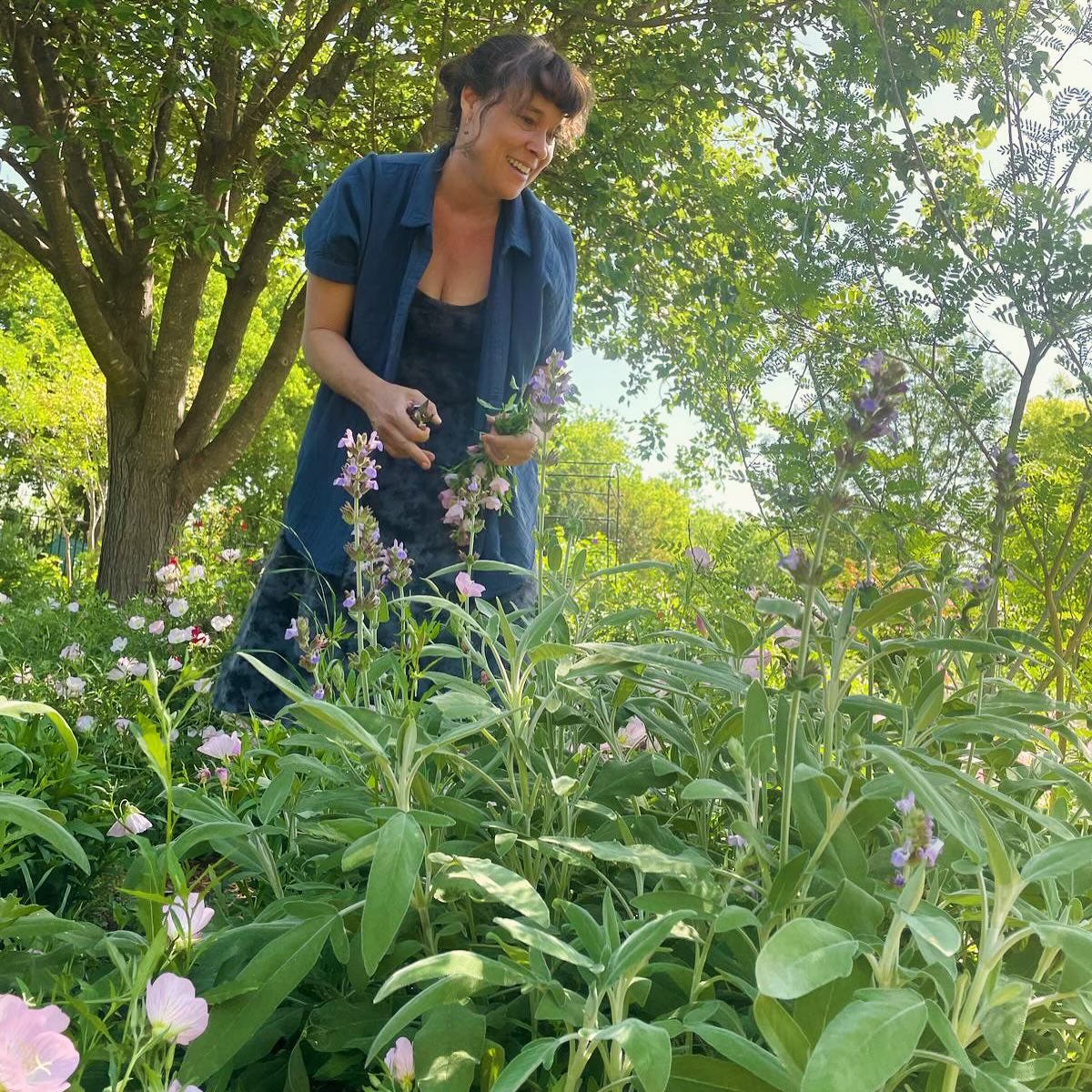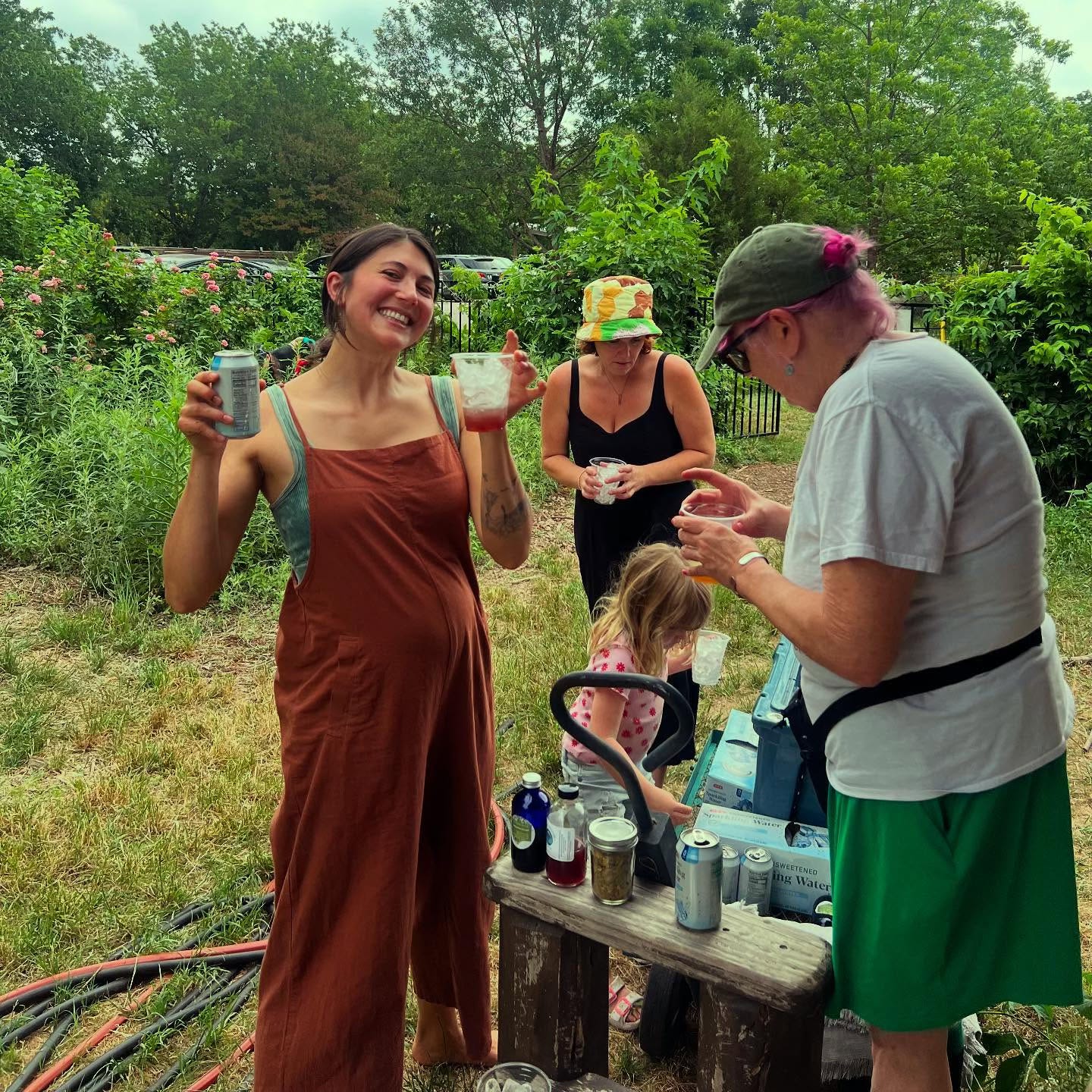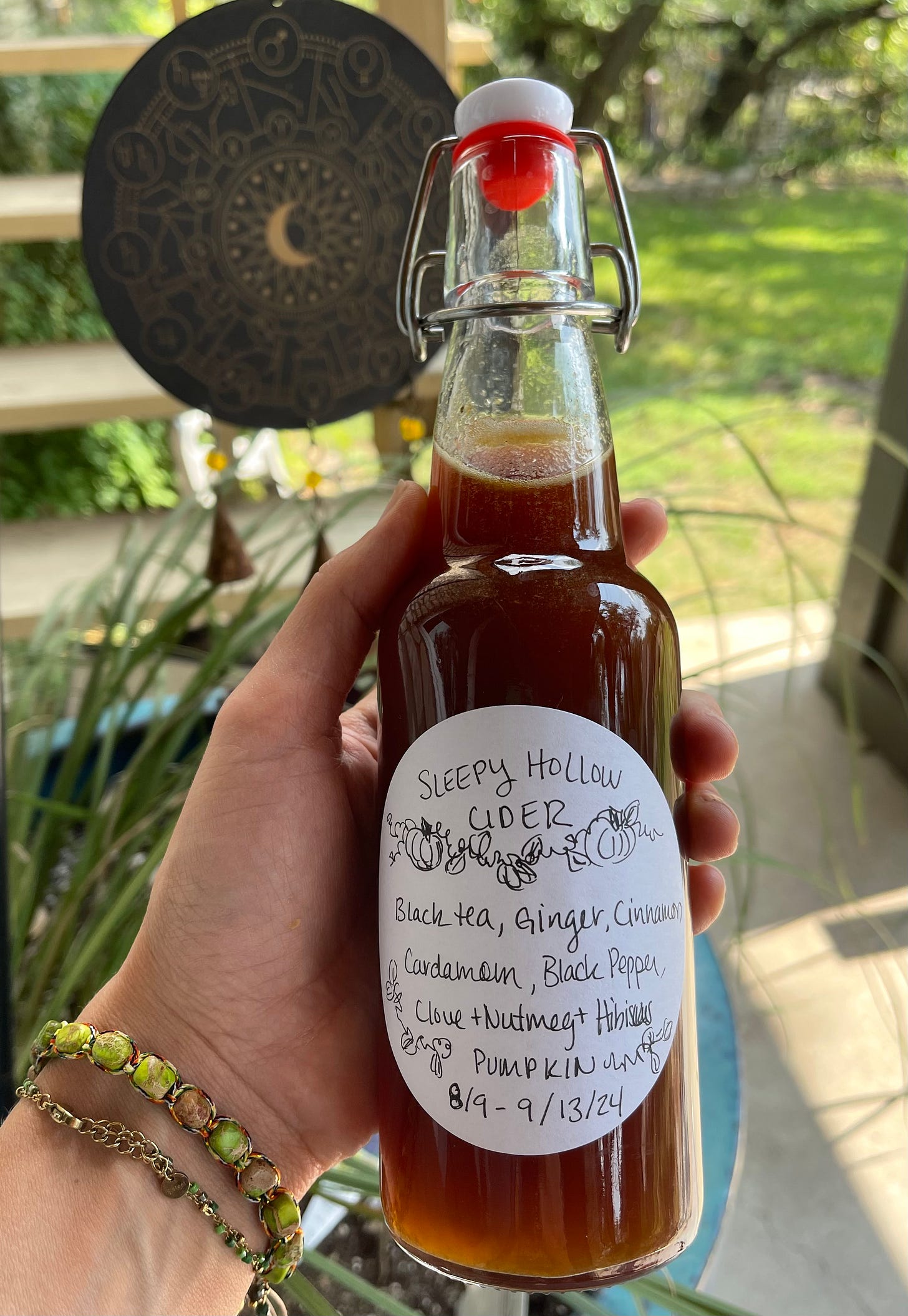Pleasure and Plant Medicine
Artist Interview with Herbalist Caroline Riley
About a year ago I attended a class at Austin’s The Herb Bar, taught by Caroline Riley of Mutable Earth Botanicals. It was a bright spring day and though I was suffering from a seasonal migraine, I was happy to sit around a small clothed table with a handful of other women, enchanted by fragrant tulsi, hibiscus, evening primrose flower and rose petals. Caroline had grown and harvested these herbs from the Food Forest on the campus of the Whole Life Learning Center where she operates her apothecary and community outreach programs in South Austin. The plants were an offering to our creative project that day: infusing apple cider vinegar and honey with herbs to make an ancient Greek folk remedy, known as an oxymel.

I had never heard of oxymels before attending this class—but from the moment that Caroline splashed a tablespoon of the deep red infusion into a jar of sparkling water for me to drink, I felt limerence brewing. The spritzer was beautiful! Pink. Sparkly. I took one sip and then another and, yes, there was a shift. I was calmer, more present. I even felt—not that my headache had been eliminated—but that the tension I had been holding around it for the previous two days had eased.
In the year since that day I have kept a habit of filling, emptying, refilling jars with herbs, honey, and vinegar in my kitchen. At the end of the day, when I want to relax into the routine of making dinner and settling in with the family, my oxymel spritzer is my companion. I’ve hosted oxymel nights with friends, shared them with my bandmates, wrapped them up as special gifts. They are a regular source of creative joy for me, supporting my body, my mental health, and my connection to nature magic.
What a pleasure it was last week to reconnect with Caroline to THANK her for bringing this powerful medicine into my life and to hear more about Caroline’s inspiring work as an herbalist. Her place-based practice, I came to learn, is truly a co-creative engagement with the Food Forest that sustains Mutable Earth and its community. Caroline’s years of working with plant medicine and permaculture, have taught her to be observant of the evolving life of the Forest, to be responsive to its surprises, and to trust in its abundance.

The Food Forest
I met Caroline in her apothecary, a yurt on the edge of the Food Forest, whose circular walls are filled with infusions mid-process, herbs drying in cloth racks, and bottles of tinctures, medicines and oxymels ready to be sold, sipped and shared. She is finishing up with a mentee when I arrive right in that sweet little window of time between working in the garden and when we both must meet our kids after school. I settle in at the long wooden work table that cuts through the center of the yurt and Caroline tells me the story of how oxymels became a part of her work as an herbalist.
“This is pretty funny,” she says. “I actually started making oxymels because I found these really sexy bottles. They were this recycled colored glass, like apothecary bottles, from Spain…They were square bodied, red, blue, and yellow or green, and they had cork tops. And I was like, I don’t even know what's going to go in these, but I have to order some.” When they arrived, one of the women who was around at that time said, What about an oxymel? “And I was just like, ooooh, pleasure medicine! And then I just go off.”
“I find myself standing in front of my jars and I’m like, who wants to go in there?” Caroline gives herself a loose framework for all of her oxymels—pairing mineral rich herbs and pungent, aromatics, “usually in the vein of an herbal action,” she says. Like Chilling Out, an infusion to help cool you down in the hot summer months (or during hot flashes), or Free Spirit, which encourages the sipper to follow their heart.
The exact ingredients, she says, can change, based on seasonal availability and what the garden happens to be offering up at any given moment. This responsiveness to the ebbs and flows of the Food Forest form a cornerstone of Caroline’s place-based herbalism. “I work with plants that grow here. My inspiration comes from the way that the plants express themselves throughout the seasons, as well as season to season.”
Caroline will still ship in herbs that she loves, like cinnamon, that just won’t take to Texas’s climate, but the plants that thrive here serve as the primary inspiration for her work. In fact, more than once, she says, plants have serendipitously shown up in the garden at just the right time. “I didn’t seed oats here,” she says. “I feel like we needed it and I called them in almost…They traveled on the wind…The wild oat population planted itself around the boundary last year.” Similarly, the nettles that grow in the Food Forest hitchhiked in the soil of a different plant that Caroline had ordered for the garden. The original plant died, but the nettles came up from the soil.

Oats and nettles, Caroline explains, are some of her favorite mineral rich herbs to include in oxymels. Nettle, she explains, “is so nutritious. It relaxes the nervous system and supports elimination in general, which I think we all need that.” Nettles cleanse the kidneys, she says, helping to release pent up anger and ease the nervous system.
“Oats,” Caroline says, “has this very soothing, almost emulsant quality to it, where it’s kind of lubricating. And in that way, it’s very much an aphrodisiac. It’s like: I feel nourished, I feel lubed up, and I feel relaxed. So what do I want to do? I want to sleep, I want to make love, and I want to, like, eat good food.”
Another favorite in Caroline’s oxymels is red clover for its support of the cardiovascular system and the way it moves any companion herbs through the circulatory system. These herbs are powerful, but also safe for most people, she says. They replenish the body’s mineral stores and delight the senses, especially when paired with aromatics or colorful herbs like purple pea flower, hibiscus, or Hawthorne berries.
Pleasure meets Potency
From the first moment Caroline gazed on those beautiful little bottles, pleasure has been the guiding force behind her oxymel infusions, but she is quick to emphasize their medicinal potency as well.
“In the beginning I was like, this is a pleasure medicine. And there’s medicinally to it, but I was holding a judgement that tinctures were stronger and that if we need a powerful punch of medicinal remedy, go to the tincture…And then there was this point where I was like, oh, this is a whole vibe, actually.” She was being asked to brew oxymels for parties and for gatherings in her markets. “And I was really able to see that the tulsi, rose, hibiscus, evening primrose, these herbs are very much potent in this honey and vinegar extraction.” The infusions noticeably heightened the energetic experience of the gatherings where they were served. “We're all like in this collective medicinal experience together and it’s coloring this whole event for people.”
I’ve had the same experience sharing oxymels with friends and family. And, I explain to Caroline, as a long-time social drinker, I was so excited to find an herbal alternative to alcohol. I suffer from social anxiety that makes me crave chemical support for mingling—but with age I’ve gotten more sensitive to the negative effects of a glass of wine. Oxymels actively shift me into a different state of mind, making me feel more relaxed, playful, and present, without severing my connection to higher functioning or leaving me with a hangover.
Caroline’s oxymels reflect her passion for sharing this plant medicine with her local community, especially its female members. From the young women in their 20s who are shy about picking up Caroline’s aphrodisiac blend, Orgasmic, to the older women who are like “heck yea! give me one of those!” Many of Caroline’s herbal offerings are crafted with women’s health in mind—whether they need support getting through postpartum energy slumps or are dealing with perimenopausal symptoms. Oxymels, Caroline explains, are an accessible source of support for those who may not be as excited about taking a tincture or tea.
Plant Support for your Creative Heart
I love everything about the process of creating oxymels—selecting my herbs, glugging that honey into the jar (liquid gold!), sketching my labels. I get such satisfaction watching the finished mixture swirl into my sparkling water, turning it purple, red, or a rich amber color. I feel like a potions master—and maybe I am!
The herbs, by supporting my parasympathetic nervous system, allow me to reach a state of relaxed creative flow with greater ease—and that feels like some serious magic to me.
More than that, the process of making an oxymel infusion contains lessons for the creative life. You teach yourself to gather your ingredients lovingly, learning what you can about their properties. Then you bring your elements together in an intuitive way.
As Caroline says, “I’m not weighing out herbs for the oxymels. It’s a folk remedy, so that means we take a jar and we fill it about halfway up with herbs, and then we do half apple cider vinegar and half honey on the volume side of things.” Ideally, you’re doing this with intention, keeping in mind the medicinal properties that the herbs bring along with them, while also infusing the process with hopes for how their magic will help you heal or transform.
Then you wait. Oxymel infusions take two to four weeks to set.
This can be the hardest part for me, creatively, giving my ideas time to rest and mature before I go digging into my harvest. I’m as addicted to instant-gratification as the next person, but the oxymel’s wait time itself is medicinal, heightening both my anticipation for the treat to come, and my curiosity as to how it will turn out. What if I brought that same approach to my writing process? Stopped pushing and let things steep for a while?
I like this as a model for how to create—harnessing my intention to work with the elements at hand, then allowing for time and space intercede when I hit the limits of my capacity.
As Caroline explained to me in her apothecary yurt last week: so much can be gained from just learning to slooooow down. Such an approach respects the seasonality of the earth, as well as the body and mind.
Caroline embodies this insight herself, having stepped back from year-round retailing at Mutable Earth to incorporate periods of dormancy and rest into her calendar year. Instead of rushing to fill orders and order in ingredients to restock her shelves, she focuses on small-scale, community-based production and teaching that allows her more time for bonding with her family (she has two kids ages 7 & 10).
Caroline’s story reminds me of how deeply our creative lives reflect and—so often—reshape our lives as a whole. Our conversation strengthens my belief in the importance of maintaining a creative practice and marks the process of making as a spiritual one. When we return, open-hearted, to our visions and strive (over and over again) to combine them with the materials of our reality—we become new. Our realities shift. Healing becomes possible.
Get creating with plants!
Mutable Earth Botanicals hosts Community Herbalism Days throughout the year, inviting folks to come and help bring in a harvest, learn about the Food Forest and make medicinals with Caroline. If you are in the Austin area you should definitely check these out—especially her OXYMEL CLASS at the apothecary coming up on June 8th!
If you can’t make the class, you can purchase oxymels from Caroline at her online shop www.mutableearthbotanicals.com, make your own with one of many recipes available online, OR you can follow this basic recipe:
Fill a canning jar 1/3-1/2 full of DRIED herbs or fruits (Avoid fresh ingredients as they can get funky, according to Caroline. Instead, save the fresh herbs to garnish your drinks).
Fill with equal parts raw apple cider vinegar and local, high-quality honey
Shake, seal, and allow to sit for 2-4 weeks before straining and bottling.
Store in a cool place and enjoy in spritzers, mocktails, or as salad dressing.
My Tips: I sometimes simplify my herb-search by using a tea blend that I like from the Herb Bar, as I did last fall for my Sleepy Hollow Cider (it tasted like oatmeal stout!) But I’ve also enjoyed making oxymels with herbs whose healing properties align with tarot archetypes—an evening primrose/lemon grass/nettle blend for the Hermit, a rose/hibiscus/motherwort blend for the Empress. Similarly, it’s been lovely to time the oxymel infusion period with astrological movements, the cycles of the moon, or the transition of a planet into a new sign. There are more than a million ways to work with this plant magic!
If you give oxymels a try, I hope you’ll pop on and let me know what you think! Thanks for reading, as always. If you’d like to support this newsletter, please consider liking, commenting or sharing so that others can find it.
If you are a current subscriber, THANK YOU! When three people subscribe based on your recommendation you will receive a personal oracle card message from me. I have some beautiful cards to share when you’re ready!






